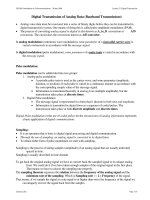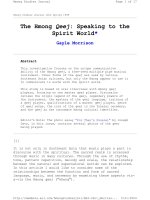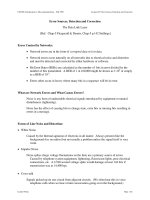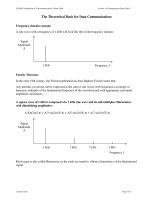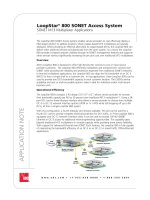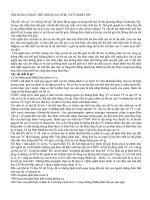Tài liệu Lecture 25: The Telephone System doc
Bạn đang xem bản rút gọn của tài liệu. Xem và tải ngay bản đầy đủ của tài liệu tại đây (59.47 KB, 6 trang )
CSN200 Introduction to Telecommunications, Winter 2000 Lecture-25 Telephone System
The Telephone System:
(Ref: Ch-4, Page-113 of your Text book)
The telephone system remains as the backbone of low-cost telecommunications services in North
America. An understanding of the telephone system is necessary when considering its use for data
communications.
Telephone: invented in 1874 by Alexander Graham Bell and patented in 1876
Single wire: In the beginning, the market was for telephones only. It is the customer who used to
wire them between telephones using single wires and the earth as the ground or the
other conductor to complete the circuit.
Bell foreseen the problem of jumbling wires all over the city and formed the Bell Telephone
Company, which opens its first switching office in Connecticut in 1878.
The original problem soon returned: to connect every switching office became unmanageable, so
second level switching offices were invented. Eventually, the hierarchy grew to five
levels.
Copper: At one time, 80% 0f AT&T's capital was the Copper in the local loops, the largest
Copper mine.
Now a days a variety of transmission media are used for telecommunication. Local loops consist of
twisted pairs, although in the early days of telephony, uninsulated wires
spaced 25cm apart on telephone poles were common. Between switching
offices, coaxial cables, microwaves, and especially fiber optics are widely
used.
Local loops still carry analog signals but all interexchange lines are carrying digital signal.
In summary, the telephone system consists of three major components:
1. Local loops (twisted pair, analog signaling).
2. Trunks (fiber optics or microwaves, mostly digital).
3. Switching offices.
We will next look at three different topics related to these three major telephone components:
4. How to send digital data over the local loops, quick answer is modem.
5. How to collect multiple calls together and send them together, the answer is multiplexing.
6. How to do switching, mechanical and digital switching.
The telephone system (commonly called POTS for plain old telephone service) enables voice
communication between any two telephones within its network.
Houses and offices are connected to a telephone company
end office (central office class 5) by a set
of two twisted pair wires (called the
local loop).
Lecture25.doc Page 1 (6)
CSN200 Introduction to Telecommunications, Winter 2000 Lecture-25 Telephone System
Local Loop: refers to 2-wire copper circuits brought to the end-user premises. In the local
loop the 2 wires are referred to as
TIP Positive (Green wire)
RING Negative (Red)
On-Hook: When the phone is "on-hook" it is not connected to the circuit. The open-
circuit voltage presented to the phone is a 48 volts DC.
Off-Hook: When the phone is lifted or connected to the local loop, about 5 volts DC is
present at the phone and current flows in the local loop. This current is
detected in the "end office" or local switch by a relay resulting in the
presentation of a dial tone on the circuit.
Ring: When the phone is ringing, a 20 Hz 85-volt RMS voltage is present on the
line.
Standard Rotary Telephone Handset (Type 500 Telephone)
Dialing is done by interrupting the line current at a 10 Hz rate. 1 to 10 pulses
are sent to dial digits 1 to 0.
(Hayes modem command: ATDP)
Touch-Tone Telephone: (DTMF or Dual Tone Multiple Frequency)
Requires DTMF circuitry on the local telephone office switch. It uses pairs
of frequencies (or "tones") to identify the digits of the number being dialed.
Two tones are used instead of one to avoid dialling by unwanted single tones
generated acidentally in front of the mouth piece. (Hayes modem command
to tone dial is ATDT)
1209 1336 1477
1 2 3 697 Hz
4 5 6 770 Hz
7 8 9 852 Hz
* 0 # 941 Hz
4
3
2
1
5
6
7
8
9
0
Pulse Dial Tone dial
Lecture25.doc Page 2 (6)
CSN200 Introduction to Telecommunications, Winter 2000 Lecture-25 Telephone System
Telephone Switching Facilities:
• Switching machines (or "switches") are used to interconnect any pair of subscribers in the public
telephone system. Within a radius of about 10 km from the "end office" (local switching office)
up to 10,000 subscribers can be interconnected directly. They share a common "exchange" or
switch. This method of making connections is called Circuit Switching.
759-XXXX
949-XXXX <====10,000 (= 9999) different phone numbers in each exchange
254-XXXX
Switching Center Hierarchy: (Fig. 4.5, p.113)
In North America there is a hierarchy of switching centers based on the number of subscribers they
handle:
Class of Office
Name of Office Function
CLASS 5 End Office (EO)
Local Office
Can connect up to 10,000 subscribers in each
exchange.
(759-, 254, 949-, 942-, etc.)
CLASS 4 Toll Center Sault Ste. Marie Handles multiplexed calls
between exchanges.
CLASS 3 Primary Center Sudbury (increased capacity to handle inter-toll
trunk lines)
In 705-949-8384 for example, the "705"
identifies the Primary center.
CLASS 2
Sectional Centers Next level
CLASS 1 Regional Centers Major switches between regions. There are
only 2 in Canada: one in Regina and one in
Montreal.
The end office is connected to a central office class 4 by a trunk line.
The central offices are arranged in a hierarchy; a class 4 is connected to a class 3 office which is connected
to a class 2 etc.
The telephone system was originally designed as an analog system, but today, most trunk lines are digital.
Lecture25.doc Page 3 (6)
CSN200 Introduction to Telecommunications, Winter 2000 Lecture-25 Telephone System
Types of Switches:
There have been 3 major types of telephone switches developed over the past 100 years.
1. STEP-BY-STEP or Direct Progressive (used to be called Strowger Switch)
The oldest style of electromechanical switches. They require a lot of space and maintenance.
There are only a few of these switches left in service.
• Generate line noise while switching calls, which causes errors in data communications.
2. CROSS-BAR or Common-Control Switches
• They too are electromechanical in nature but have certain advantages over step-by-step
switches. They consist of electrical contacts arranged in a grid.
• They are faster, take up less space and are less expensive to maintain than step-by-step
switches.
• They are rapidly being replaced by digital switches.
3.
DIGITAL SWITCHES (ESS or Electronic Switching Systems)
• Digital switches are basically computers using stored-program control to handle the
switching of calls.
• They can handle 100,000s of subscribers at a time.
• They are much faster, more reliable and flexible.
• They don't generate electrical noise when switching making them more desirable for data
communications.
• Because they handle so many subscribers it may be disastrous if they fail.
• Virtually all common carriers now have digital switching.
Leased Lines vs. Dial-up Lines:
Leased Lines
• Leased phone lines (also called private circuits or dedicated circuits) are phone lines that are
available permanently (without having to dial) from one site to another.
• They are leased on a monthly basis and you pay for them whether you use them or not. Can be
expensive unless usage is high.
• You never get a busy signal, but you are always connected to the same site.
• Ideal for permanent computer links between two sites that have significant traffic
like air-line reservation terminals or Internet connections.
• Lines can be conditioned for high quality data transmission by having noise and distortion
minimized.
Dial-up or Switched Circuits
• Normal dial-up phone lines are inexpensive but have some disadvantages:
• Calls may be blocked if there are no lines available or the line may be busy.
• There is a dial-up delay.
• Long-distance charges are based on usage so heavy use will be expensive.
• May get poor quality connections since each time you dial a long-distance line you may get a
different circuit.
Lecture25.doc Page 4 (6)
CSN200 Introduction to Telecommunications, Winter 2000 Lecture-25 Telephone System
Store-and-Forward Switching:
If a called device is busy, the central switching office stores the incoming message and retransmits it to the
destination when it becomes available. Commonly used for data communications because it provides the
highest level of throughput on circuits.
Transmission Impairments:
Transmission lines suffer from three major problems:
Attenuation - is the loss of energy as the signal propagates outward. The amount of energy lost depends
on the frequency. Each Fourier component is attenuated by a different amount.
Delay distortion - It is caused by the fact that different Fourier components travel at different speeds. For
digital data, fast components from one bit may catch up and overtake slow components
from the bit ahead, mixing the two bits and increasing the probability of incorrect
reception.
Noise - unwanted energy from the sources other than the transmitter. Thermal noise, cross talk, impulsive
noise.
• These transmission impairments and the bandwidth limitation makes digital signaling (have a wide
spectrum) unsuitable for transmission over the local loop.
• To get around the problems associated with the dc signaling or digital signaling, especially on
telephone lines, ac signaling is used. A continuous tone in the range 1000Hz to 2000Hz, called a sine
wave carrier is used. Its amplitude, frequency, or phase can be modulated (changed with the
information) to transmit information.
Brief Summary of PBX’s, Cellular Technology and Fax Machines
PBX:
(Ref: Appendix-B, Page-426 of your Text book)
PBX (Private Branch Exchanges) is a switch also called a switchboard. You can think it as a miniature
version of the large scale switching exists in a Telephone company.
PBXs (Private Branch Exchanges) are used by organizations to manage their voice (and sometimes their
data) communications. They reduce costs by reducing the number of connections to the telephone
company’s trunk lines. Essentially a PBX is like a “smart” switch placed on your premises instead of the
phone company’s.
There are digital PBXs and wireless PBXs (operates just above 900MHZ).
Cellular Technology:
(Ref: Appendix-C, Page-430 of your Text book)
Commonly used to provide wireless mobile (high frequency radio) telephone service but is also used for
data communications, pagers and personal digital assistants (PDAs). Regions are divided into cells, each
with its own antenna and mobile phones transmit and receive using the nearest antenna. They are
automatically switched from cell to cell as they travel. Using frequencies in the 870 to 890 MHz range
Lecture25.doc Page 5 (6)
